Innovation and New Technology are Drivers to Progress
For centuries, technological leaps have powered our lives and had a profound impact on the way we live, work and communicate. From the steam engine to the internet and everything that followed, technology has enabled great leaps forward for humanity. Now, looking ahead to the net zero transition, what role can technology and innovation play in a sustainable future? Following COP29, Steve Smith, Chief Strategy and Regulatory Affairs Officer at National Grid, explores the issue.

We’re clear that one of the biggest contributions we can make to the energy transition is the build-out of the infrastructure needed to enable clean electricity to flow from where it’s generated to where it’s needed in our homes and businesses. We therefore agree with the COP29 Presidency recognising grids and innovation as two key enablers to achieving net zero.
And our investment means we’re driving the energy transition forward at pace. In the UK, we are planning 17 major new infrastructure projects that will connect clean, low-carbon power across England and Wales. We call this the Great Grid Upgrade – the largest overhaul of the UK’s electricity grid in a generation.
In the US, we are delivering our Upstate Upgrade plan in New York, with a historic $4 billion investment to rebuild more than 1,000 miles of our transmission system, enabling 70% renewable electricity in the state by 2030. It’s the largest transformation of New York’s electricity grid in generations and spans 70+ projects to deliver a smarter, stronger, cleaner grid.
Like our National Grid predecessors who established the world’s first integrated grid in the 1930s and the supergrid in the 50s, we recognise that the energy transition requires innovative thinking to ensure we have a transmission network that is fit for both the needs of today and tomorrow.
But we’re not just building new lines - we’re getting the most out of the existing grid, too.
Innovative solutions are already being deployed to boost efficiencies and help accelerate progress. For example, we are investing in and implementing a series of trials with TS Conductor on high performance conductors for our power lines, thereby providing up to three times more capacity than existing cables. This type of technology will not help to reduce line losses but also construction costs and scope 2 emissions. Testing is ongoing, with installation anticipated to begin in 2025.
We’re also investing in real-time monitoring of our transmission lines via LineVision’s non-contact sensors to bring more energy online and help support growing demand. We’re also using cutting-edge software developed by Sensat, to enhance the planning and design of customer connections and infrastructure projects. The technology enables us to identify and mitigate risks more effectively, reducing costs and planning time.
In homes and businesses, we’re considering how Electric Vehicles can support power-grid management and create Virtual Power Plants to enhance grid resilience. Our Electricity Distribution business has been testing one software solution from ev.energy that schedules vehicle charging to periods of lower demand on the grid. This not only enhances network reliability and resilience but also has the potential to reduce the cost of charging, as the energy is off-peak. Already proving a success, we’re now looking at how we can scale this further.
Much of the work we are doing is possible because of the works of National Grid Partners, our corporate venture and innovation arm, which launched in Silicon Valley in 2018. Since then, we have invested $500 million in almost 50 companies, including Grid Enhancing Technologies and advanced conductors. And those investments are creating further momentum in the market. The startups in our portfolio have attracted more than $3 billion in additional funding since our initial involvement with them. These are the kinds of financial commitments the energy and innovation industries must make for the good of our customers and the planet.
We firmly believe such collaborations will be key to success. By enabling the sharing of knowledge, technology and expertise on a global scale, we can reach a net zero future faster and more efficiently. At a recent meeting of our NextGrid Alliance – a network of senior utility innovation leaders from over 120 utilities around the world – we continued to share best practices and challenge each other to think bigger.
We are proving time and again that technology can and will support the energy transition and the decarbonisation of our world. And it is vital that we continue to embrace the possibilities and strive towards a more sustainable and efficient energy future.
ENDS
Contact for media information only:
Rebecca Lawlor – Rebecca.lawlor@nationalgrid.com
Press office – 01926 656536
Notes to editors:
About National Grid
National Grid sits at the heart of Britain’s energy system. The individual companies in our group run the networks and infrastructure that connect millions of people to the electricity they use every day.
Our regulated businesses own and develop the high voltage electricity transmission (ET) network in England and Wales, and the electricity distribution (ED) network in the Midlands, Southwest England and South Wales. Operating separately from these core regulated units, National Grid Ventures (NGV) focusses on competitive markets, investing in energy projects, technologies, and partnerships such as electricity interconnectors.
We bring energy to life, with an ambition to serve our customers well, support the communities in which we operate, and make possible a clean, affordable, and resilient energy network of the future.
Facts about our networks in England and Wales:
- Our transmission network takes electricity generated from different power sources and carries it at high voltage via our 4,500 miles of overhead line, 1,500 miles of underground cable and 350 substations.
- Our distribution network delivers electricity at lower voltage from our transmission network to where it’s needed in the regions we serve, via 60,000 miles of overhead line and 83,900 miles of underground cable.
Find out more on our website about the difference between our networks.






